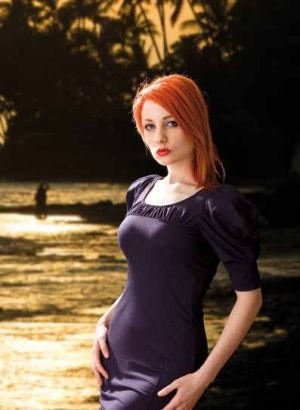articles/Lighting/lightingfordigitalpart14-page2
Lighting for Digital Part 14 - part 2 of 1 2 3
by Dave Montizambert Published 01/04/2010

Let's take a look at one of my Hair Knock Out recipes by applying it to an image I shot using my simulated sunlight lighting technique (see sidebar entitled Indoor simulated sunlight set-up) on model Christiane www.ulorinvex.com during a masterclass at the Societies' 2010 Convention, see Image 003 & 004.
Disclaimer: this Fast Blend Mode Knockout technique works really well if the replacement background is either dark in tone, or light in tone, mid-tones can be tricky.
Indoor simulated sunlight setup
Whilst planning the image for my lecture demo, I chose a couple of outdoor background scenes from Hawaii that I thought would work nicely, see Image 001 & 002. In both instances, Christiane's hair would fall against a dark area of the Hawaiian land/seascapes and so a black backdrop was selected to shoot her against for the lighting demo, see Image 003. Also for a realistic looking background match up, make sure to light the subject from same direction as sunlight direction in background scene. With this in mind, Christiane was illuminated by light reflecting off a 1.3 x 2m, white nylon fabric stretched over a panel frame placed in front of her on the camera left side of the image frame - see lighting diagram Image 004. A shutter speed of 1/125 was selected to overpower the room lights and the aperture was set to f 8 to correctly expose Christiane with the aforementioned panel main light source. The origin of the light energy for this main light source came from a studio strobe placed behind her on the camera-left side of the image frame. This light origin also provides heavy, dramatic back-lighting for Chris giving her separation from the dark background. Reflective meter readings were taken off the black backdrop to make sure that any light spilling onto the background was minimized through light origin placement, goboing, and feathering, to ensure a minus 4 1/3 stop reflective reading. To fill in the subject shadows, a second reflector panel was placed on the camera-right side of Christiane, as shown in Image 004. This fill light source caught stray light from the backlight origin and redirected it onto her dark side. An incident meter reading showed that the fill panel reflected 2 stops less light onto Christiane than did the main light panel.
Please Note:
There is more than one page for this Article.
You are currently on page 2
- Lighting for Digital Part 14 page 1
- Lighting for Digital Part 14 page 2
- Lighting for Digital Part 14 page 3
1st Published 01/04/2010
last update 09/12/2022 14:55:50
More Lighting Articles
There are 0 days to get ready for The Society of Photographers Convention and Trade Show at The Novotel London West, Hammersmith ...
which starts on Wednesday 15th January 2025





